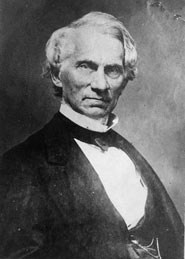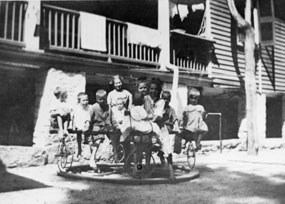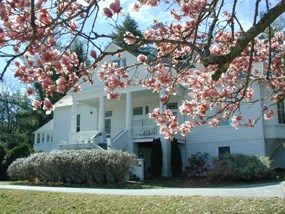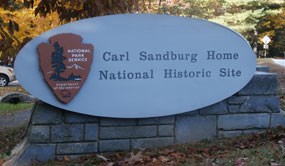|
The property known today as Connemara has a long and complicated history. The main house was built in 1838 by an enslaver who served in the Confederate government and fought throughout his lifetime to promote the theory of white supremacy. The next two property owners were prominent businessmen who also worked to maintain racial segregation after Reconstruction. Then in 1945, over a century after the estate was built, Pulitzer Prize-winning writer Carl Sandburg purchased the property. Sandburg moved from Michigan to Connemara to have a more suitable location for his wife and daughter to raise dairy goats. In the Connemara years Sandburg published "Complete Poems" in 1950, delivered the Lincoln Day address to a joint session of Congress in 1959, worked as a Hollywood film consultant, received the Presidential Medal of Freedom from President Lyndon Johnson in1964, and the NAACP lifetime achievement award in 1965 for his coverage of the 1919 Chicago race riots and for his "life-long struggle to extend the frontiers of social justice." Sandburg died on July 22, 1967 at his home in Flat Rock, NC, at age 89. The nation mourned him as writer, biographer, folksinger, lecturer, and Poet of the People who spoke for those who did not have words or power to speak for themselves. He was eulogized on September 17,1967 at the Lincoln Memorial. His ashes were buried at his birthplace in Galesburg, Illinois on October 1st. In 1968 Congress authorized Carl Sandburg Home National Historic Site, the first unit of the National Park Service to honor a poet. You can learn more about the history of the site and prominent figures through the links below: Historic Resource Study of African American History at the Site This Historic Resource Study, Black Lives and Whitened Stories: From the Lowcountry to the Mountains, by David and Anne Whisnant, explores the history of African Americans and the larger racial dynamics at Carl Sandburg Home National Historic Site over a period of more than a century, beginning in the 1830s. 
Memminger Era In the mid eighteen-twenties, Flat Rock became a popular summer destination because it offered release from the oppressive heat and the perfect climate to recover from illnesses. Many of its summer inhabitants were travelers from Charleston, South Carolina. In fact, the “Charlestonian” influence was so large that the area was referred to as “The Little Charleston of the Mountains.” Of the wealthy travelers from Charleston was Christopher Gustav Memminger, builder of what is today Connemara. Memminger worked as a lawyer in Charleston, SC and gained prominence as the Secretary of Confederate Treasury during the Civil War. He established the property in 1836 to use as a vacation home with his family escape the heat and insects that inhabited the South Carolina lowland during the summer time. He called the estate “Rock Hill” due to the exposed rock faces throughout the property. By the outbreak of the Civil War, Rock Hill included the Main House, Kitchen, and two surrounding slave quarters. The 1850 census taken in Charleston indicates that Memminger had twelve slaves. The two slave residences closest to the main house likely housed cooks, maids, and butlers for the family. The 1860 Henderson County census listed six male slaves in Memminger’s possession. Memminger resigned from his post in 1864 and retreated to Rock Hill. Shielded from battle by the mountains, Flat Rock, however, did not escape the brutality of war. Memminger, his family, and his friends used the place as a hideout due to the large presence of “Bushwhackers” and the lack of civil or military law in the area. Mansions in the area were raided, but there is no recorded account of Bushwhackers entering Rock Hill. The Civil War ended and Memminger returned to Charleston to continue his law practice. After Memminger’s death, Rock Hill was sold to Colonel William Gregg, a native of South Carolina and former Confederate soldier. Though he owned Rock Hill for ten years, he never occupied it. 
The property was then purchased by Ellison Adger Smythe. Smyth was a native of Charleston born in 1847. When he purchased Rock Hill at age 52, he was not only a Confederate veteran, but a leading industrialist. Starting out with a simple cotton mill, he went on to become a textile giant involved with publishing and banking. At one point, he ran thirty six corporations, and a dozen banks. In his role as an industrialist, Smyth's politics were typical of his status. He was opposed to both unions and child labor laws, believing that young teenagers (12-16) were the most productive workers in his mills. This is in stark contrast to the ideals and beliefs being written in Chicago by the young future owner of Connemara, Carl Sandburg. The property saw major changes during the Smyth Era. The name was changed to “Connemara” in honor of the family’s Irish ancestry. Most importantly, it was during this time that the home was used as a consistent full time residence and not just a summer home. The barn area expanded to house lambs, sheep, dogs, oxen, fowl and champion milking cattle. He added a side pasture, walking trails and vast vegetable and flower gardens. Captain Smyth died at Connemara in 1942 at age ninety-four. 
Sandburg Era Lillian Sandburg’s prize winning Chikaming Goat Herd was rapidly expanding on the shores of Lake Michigan. In 1945, she decided it was time to find a home more suitable to the needs of her farm. She visited Connemara and was impressed with what she saw. The 245-acre farm offered plenty of pasture land, farm buildings, and inspiration. Carl, upon his later visit, agreed but said it was quite the “baronial estate for an old socialist!” Sandburg produced about a third of his works and received his second Pulitzer Prize while living at Connemara. 
Connemara Today Carl Sandburg died in his home on July 22, 1967 at age 89. The next year, Mrs. Sandburg sold the property to the National Park Service (NPS). She realized, however, the significance of her husband’s work to the culture of America and donated all the family’s belongings to the NPS so that Carl’s legacy could be preserved forever. The park opened in 1974 as the Carl Sandburg Home National Historic Site. As a unit of the National Park Service, the home of the People’s Poet for twenty-two years now belongs to his subject, the people. |
Last updated: October 21, 2024
